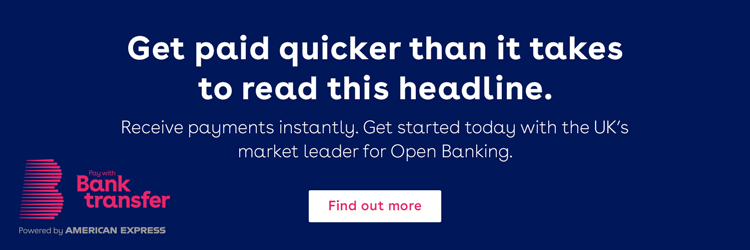
Holly Coventry
VP, International Open Banking Payments, American Express
Merchants should consider offering their customers the option to pay using Open Banking, insists Holly Coventry, VP, International Open Banking Payments at American Express.
What is Open Banking?
It’s technology that makes payments faster and easier by sending funds to a merchant’s bank account at the click of a button — which benefits customers and vendors alike. It’s also safe and secure because, unlike paying with debit cards or via BACS, no financial information is shared with anyone. To initiate a payment, all the customer has to do is authorise it through their online banking.
How does Open Banking differ from BACS?
It’s more straightforward. For example, say you want to pay a plumber for services rendered. With Bankers’ Automated Clearing System (BACS), you would need their sort code and account number to make an online transfer.
With Open Banking, all the plumber has to do is send you a link via text message or email, which includes details of the amount to be paid. To agree to it, you click on a button and select which bank you would like to pay through. If you’re using your mobile, you’ll be taken securely to your banking app, via the biometrics or passcode on your phone, to authorise the transaction. You don’t need to manually input their banking details.
How popular is Open Banking?
It is growing faster than contactless payments did on the first launch. Open Banking Limited — the Government entity promoting Open Banking — reported that 7 million consumers and SMEs used Open Banking services in January. We launched our own Open Banking-powered payments product, Pay with Bank transfer, towards the end of 2019. JustGiving was one of the first UK merchants to implement it.
7 million consumers and SMEs used
Open Banking services in January.
Why has retail been slower to adopt Open Banking?
There are a few reasons. First, debit cards aren’t perfect — but they are existing payment products that do the job for both the merchant and the consumer. That makes change harder, particularly in e-commerce scenarios. Also, initially, it was challenging for vendors to make refunds using Open Banking technology. Now, the capabilities and infrastructure have improved, so that’s no longer the issue.
Plus, I think some retailers thought Open Banking would simply mimic debit cards. They need to think outside the box and use it to make small, gradual innovations that will alleviate pain points for the consumer and ultimately enable more Open Banking use cases.
Powered by American Express but open to everyone, we’re the future of frictionless payments.
How does Open Banking benefit retail customers?
Apart from being more convenient, it gives them more control because, without authorisation, the payment won’t leave their bank account. What’s more, most banking apps will allow consumers to check their bank balance first to ensure they have the necessary funds before they make a payment via Open Banking. They don’t have that visibility with debit cards.
How does Open Banking benefit vendors?
It helps with cash flow because they receive money in their bank account instantly. It’s also another option for their customers. We’re working with several retailers on using our Pay with Bank transfer product as a way to build better customer experiences. Ask any vendor: good customer experiences are essential.
We carried out research earlier this year, which revealed that 42% of shoppers wouldn’t return to a retailer with a slow checkout and payment process; and over a quarter of those surveyed (28%) would not purchase from the retailer again due to lack of choice when it comes to payment options. A further 69% said they don’t want to waste time entering unnecessary details when shopping online, and 61% said they would like greater control and visibility over their finances when making payments. So, I think we’ll see Open Banking increasing in the world of retail.



